The forecast was rain, so I took an umbrella to Green Templeton College for the tour I had booked through Oxford’s Civic Society. It’s not a famous college. For a start it’s relatively new as Oxford colleges go; Green College was founded in 1977, merging with Templeton College in 2008, and though just a short distance up the Woodstock Road it’s too far out of town for tourists to be much interested. But now the new exciting modern architecture of the Radcliffe Observatory Quarter on to which it backs is attracting more interest in this part of the city. So I thought it best to grab this opportunity before the place is discovered. Besides this is far more than a college with a pretty garden and a charming clock tower at its entrance. The site boasts the longest running weather station in the country. And we’ve been promised a look inside what must be one of my favourite buildings in Oxford, the ravishing 18th century Radcliffe Observatory, with its honey-coloured replica of the ancient Athenian Tower of the Winds. It’s the star-turn around here, the dominant architectural feature not only of the college that has taken over its stewardship, but also of the new award-winning architect designed university quarter which takes its name.
Our guide is the Head Gardener Michael Pirie. Despite having little knowledge of horticulture when he applied for the job, he says he accepted because he liked the idea of being his own boss. And the powers that be, have clearly allowed him to get on with it because he’s been in the post for over 40 years. A huge Cedar of Lebanon that he planted on the front lawn of the Observatory when he first arrived is testimony to his long period of service. And now he’s called upon to show people like me around the place, which he does with enormous knowledge and a custodial protectiveness in between tending the borders. He’s still wearing the green trousers and checked shirt of his gardener’s gear to prove it.
Pirie shows us plans of the place to understand how the site evolved. First came the Observatory, built on an open swathe of countryside in North Oxford frequented by highwaymen and paid for by money bequeathed by John Radcliffe. A statue of Radcliffe by Martin Jennings stands on the front lawn. He looks rather pleased with himself but then as half the buildings in Oxford seem to be named after him you can’t blame him. The Observatory cost three times the amount projected and took 25 years to complete. But it was reckoned to be the finest in Europe when it was finished. Built out of local Bibury stone and laid out on an east west axis to align with the prime meridian with clear views of the horizon, it had a lower floor with slots in the wall and roof, through which quadrants, and other scientific instruments could project and rotate, and tables laden with astrolabes, spheres and the like, many of which you can still see on display in the History of Science Museum on Broad Street. Above came a semi-circular upper floor, and then a decorated top floor tower flooded with light from tall windows, two of which could be opened to wheel out the telescopes to study the planetary orbits. A sweeping drive bought carriages through open parkland to the front entrance, with parking at the back (the main entrance to the college today, the stable block now the college bar) and a grand Observer’s house for the Professor of Astronomy next door.
And so it remained until 1935. Outdated telescopes and light pollution from a growing city now powered by electricity, demanded a different approach and so the university department was moved to the clearer skies of South Africa. Until Green College, The Observatory became home to the Nuffield Institute for Medical Research, playing host to among others an Ear Nose and Throat surgeon called William Lund who was researching the psychological effects of swallowing. According to Terence Ryan’s article on the subject, for this Lund engaged the services of a local from the Royal Oak pub across the road from the Radcliffe Infirmary, who was asked to drink eight pints of beer and then a further pint under observation at the Institute, before being hung upside down by his ankles to record the effects of swallowing and the prevention of reflux. Desperate to work out how it was done, he also persuaded a sword swallower from St Giles Fair to come back to the Observatory to be filmed.
After the initial chat Pirie now leads us through a side gate out of the college and into what presently is a building site for the Schwarzman Centre for the Humanities. It’s an open public area from which you can stand and admire the whole southerly aspect of the building. When I was growing up, the Observatory was hidden behind what had become a mass of sprawling outbuildings for the Radcliffe Infirmary, enticing glimpses of small fragments of the mystery building occasionally visible over the roofs of the surrounding terraced housing. But once the hospital was relocated to Headington, the space left behind has given the magnificent frontage of The Observatory the chance to breathe again. It may no longer be set in rural parkland, but its multiple reflections in the myriad of mirrored glass windows of the sparkling new structures that now surround it, are really rather wonderful.
James Wyatt’s ‘Tower of the Winds’ as it became known was inspired by the 1st century BC building of that name in Athens. Each of the eight sides of the tower is decorated with an allegorical flying figure representing the eight directions of the wind. Facing us is the south wind, sultry and wet with his upturned amphora of rain. His counterpart on the north face wears warm clothes and carries a seashell with which to blow his howling tempests. Carved in situ all are equally charming. Beneath are panels showing the signs of the zodiac, their perfect preservation due to the use of Coade stone, a revolutionary composite material that had just been invented. Other panels (only seen from inside the college) are classical tableaus to represent morning, noon and dusk. And the tower is topped by the figures of Atlas and Herakles stooped under the weight of the globe on their shoulders. It’s all rather breath-taking.
Heading inside and the ground floor has been reinvented as a college dining room, the second level a comfortable common room and library. There are portraits of past wardens on the walls including Green College’s first, Richard Doll, the physician responsible for linking smoking to lung cancer. But it is the tower room we have all come to see, a vast open space with huge windows, a small telescope set up to remind us of the larger versions that went before. And if you have a head for heights its worth climbing the steep metal staircase to the upper balustraded level, where there are views of Oxford from every direction.
A gap in the clouds and back down on ground level we have a chance to explore Pirie’s own work in the college garden. He set out to create a place of beauty and that he has, swathes of lavender and love- in- the- mist bordering the curved meandering pathways set out in the 18th century. He has kept the naturalistic, informal feel of the prevailing style when the place was created, shape colour and form bought together to produce a landscape that sets off a central garden structure in this case, the Observatory. And there’s a lovely greenhouse straight out of Beatrix Potter. Filled with seedlings and horticultural specimens I imagine that this must be the nerve centre of his mini fiefdom.
One more stop before we leave in front of the fenced off rectangle of grass set aside for the Radcliffe Meteorological Station, and the moon landing style equipment that goes with it. Recordings of air temperature, rainfall and sunshine were started here in in 1772 and daily readings have been kept since 1815, (the number apparently still used as the code to one of the garden gates, though Pirie won’t tell us which one). It’s the longest continuous series collection of data of single site weather records in the British Isles, from which scientists can assess the trends in the weather over two centuries. A barometer of climate change in your back garden. Fabulous.
As we say our goodbyes, and as if on cue the sun breaks through, so I head back to the new Observatory Quarter to take photographs of its star attraction in the sunshine. It’s hard to believe the site narrowly escaped proposals to stick a road through the middle. And we have John Betjeman and The Oxford Preservation Trust to thank for stopping the Observer’s Garden from being replaced by an accommodation block for nurses. But this new development has breathed new life into this old building. And with college backing it looks set to be around for a whole lot longer.
After publishing this blog I received an email from Dr Laurence Leaver who was a student and fellow of Green Templeton College and is now my GP at Jericho Health Centre. He recalls stories being told about the gardens being used to graze sheep for the physiology department in the 1960’s but isn’t sure if this is true. His interview about his time as a medical student at the college is well worth a read.
https://www.gtc.ox.ac.uk/news-and-events/news/an-interview-with-senior-doll-fellow-laurence-leaver
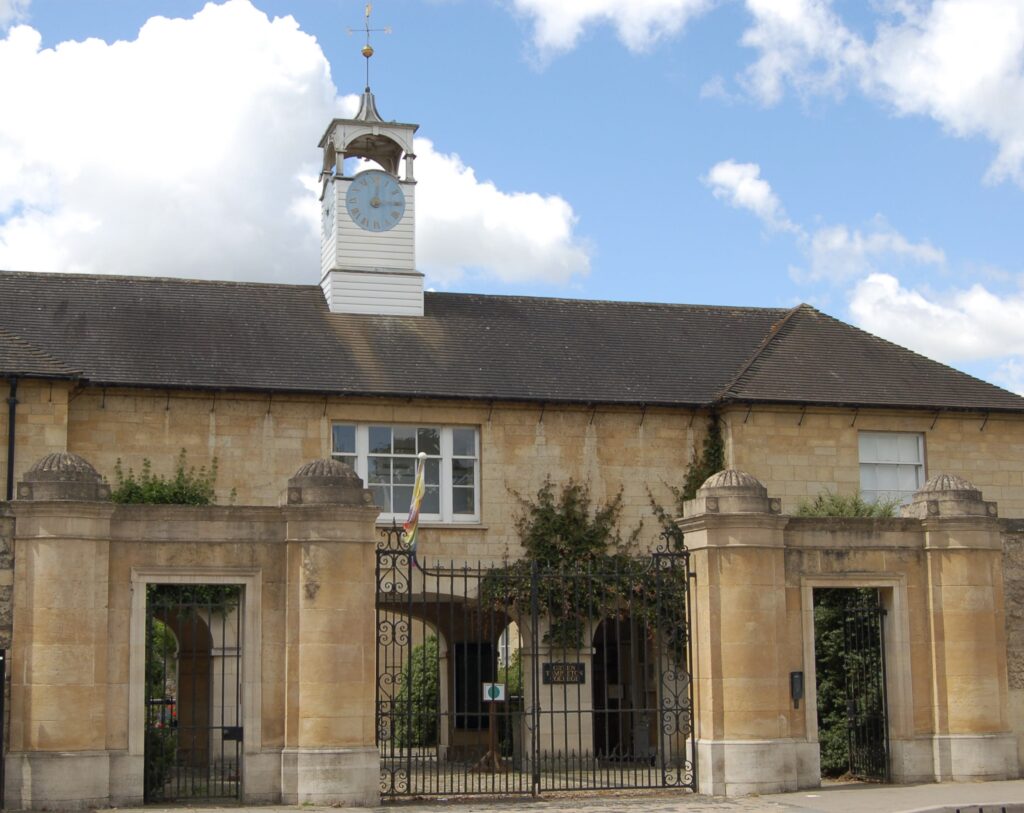
The entrance to Green Templeton College on Woodstock Road. Jack Lankaster’s idea was to create the impression that you were entering the courtyard of an 18th century country house with an estate clock over the archway. Appropriate and in keeping with the stable blocks and the Observatory behind. There are plans to replace this with student accommodation.
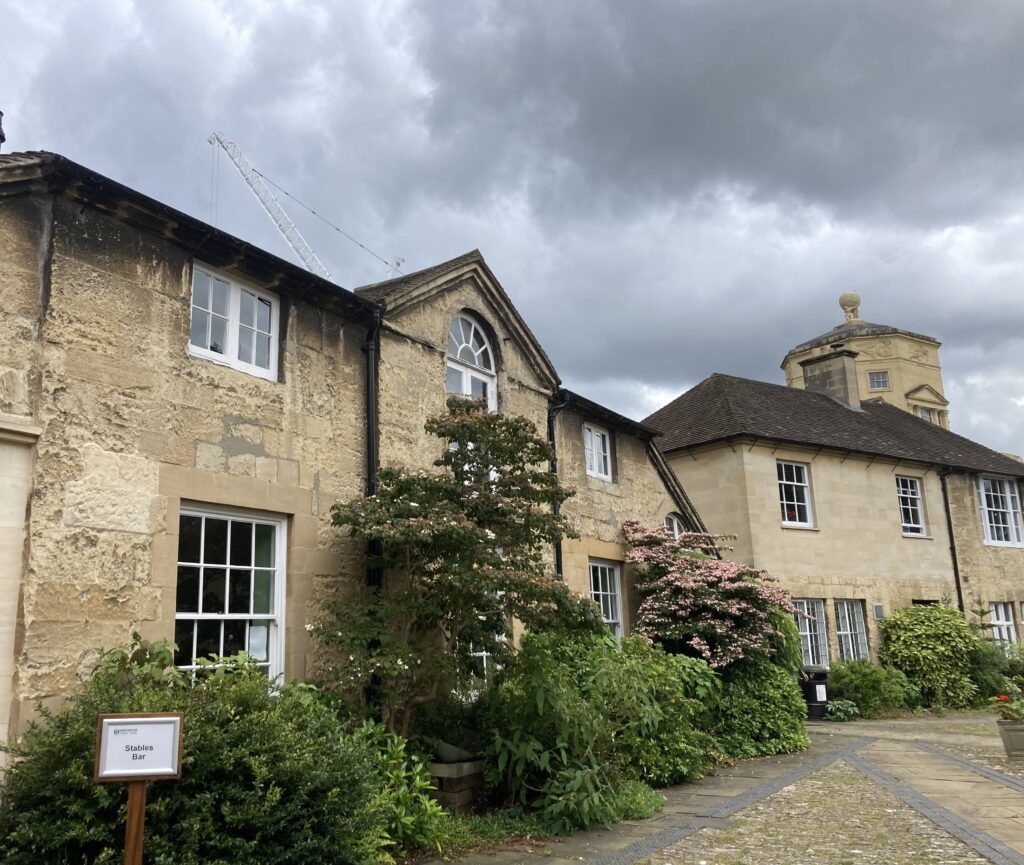
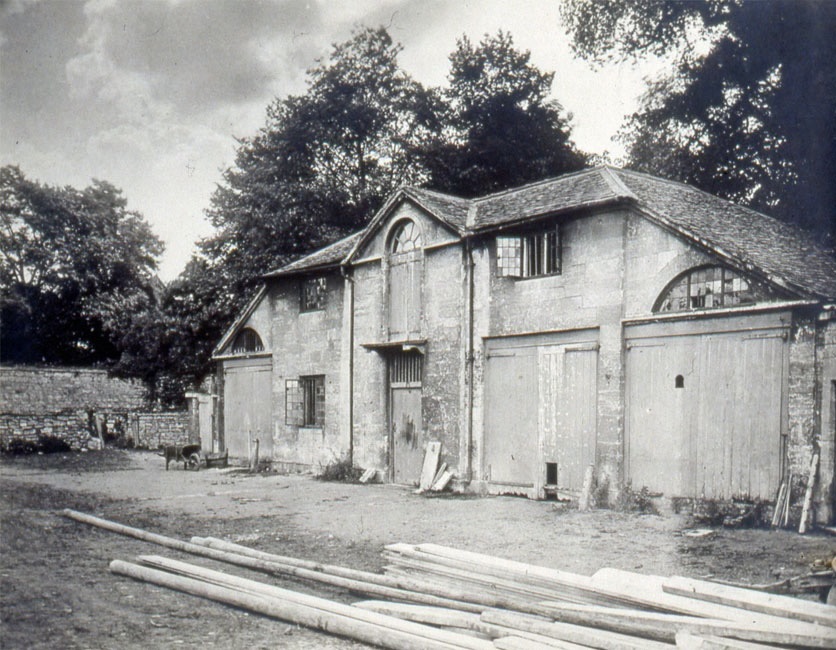
The old stable block that once served the Radcliffe Observatory and its back entrance; now the college bar (left). Back in the 1920’s when it was being used as a garage. (right)
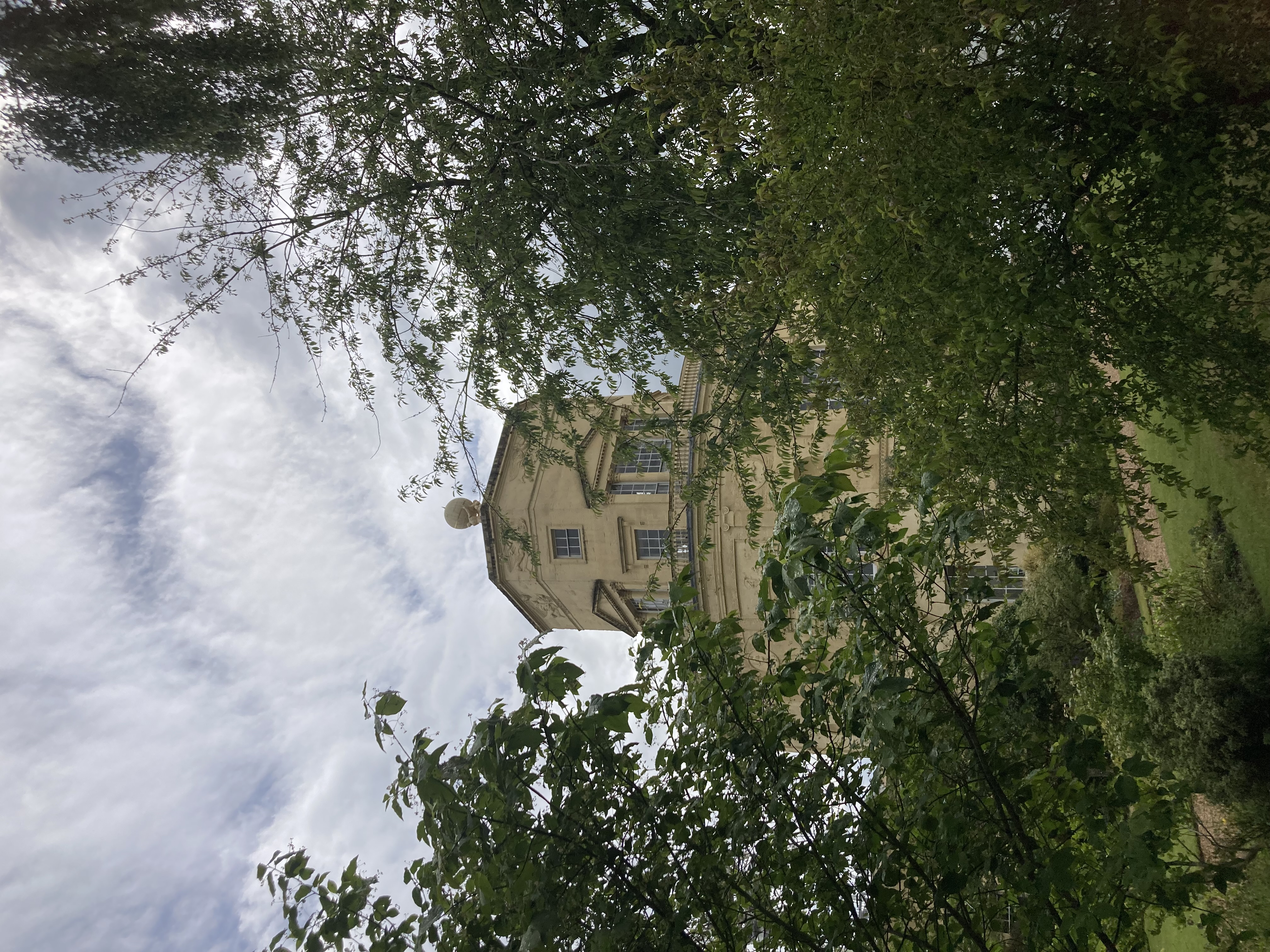
Approaching the Observatory through the gardens of the college.
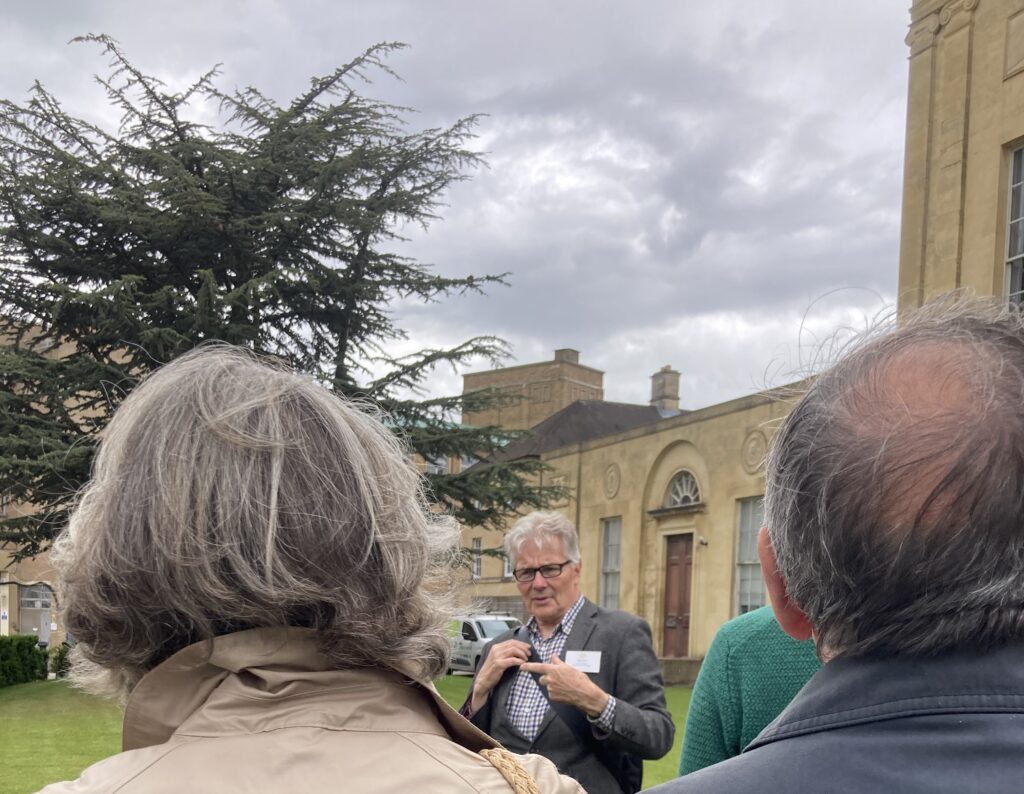
Michael Pirie, Head Gardener of Green Templeton College for some 40 years.
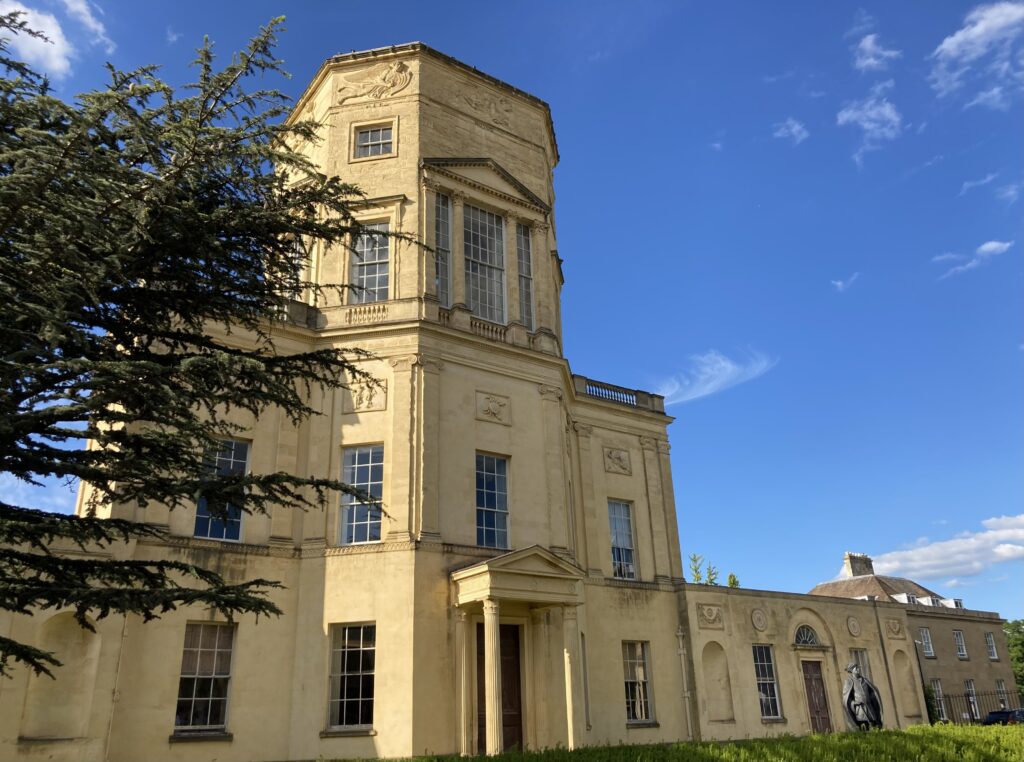
It was Thomas Hornsby, the then Professor of Astronomy who petitioned the Radcliffe trustees to build a world class observatory. It was expected to cost £7000 but ended up costing over £33,000. The architect Henry Keene drew up designs (now lost), but the project was taken over by James Wyatt, whose idea it was to build the Tower of the Winds. It is thought the design for the Observer’s House next door that you can just see in this picture, was Keenes.
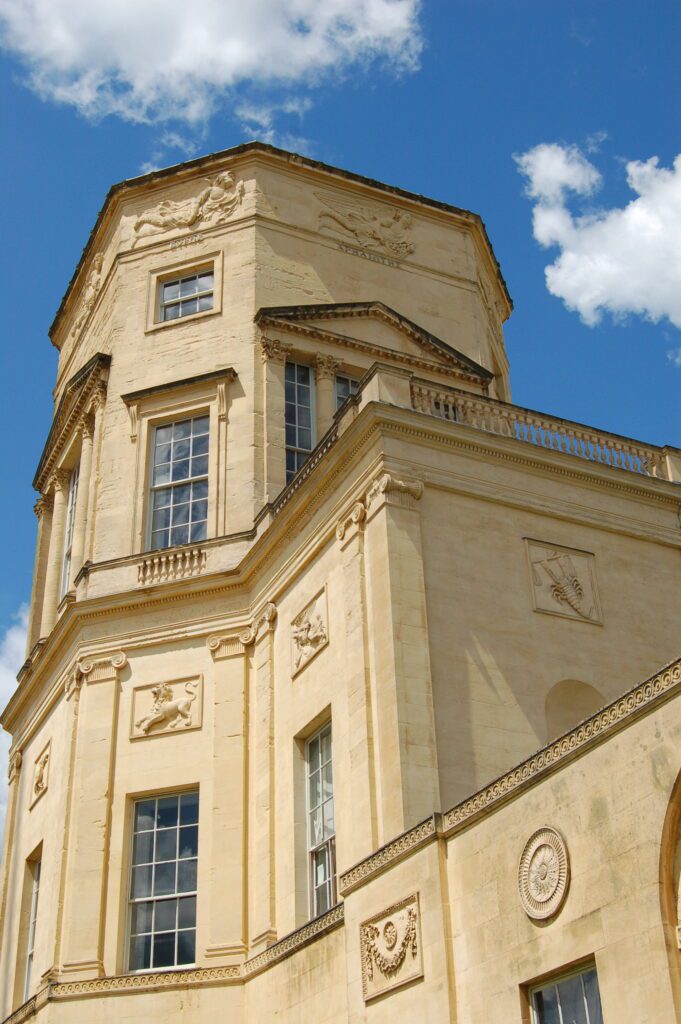
The East wind, Apeliotes, bringing gentle rain and abundant fruit and vegetables. Next to him is Euros, dressed in a warm cloak as he brings sultry and gloomy weather.
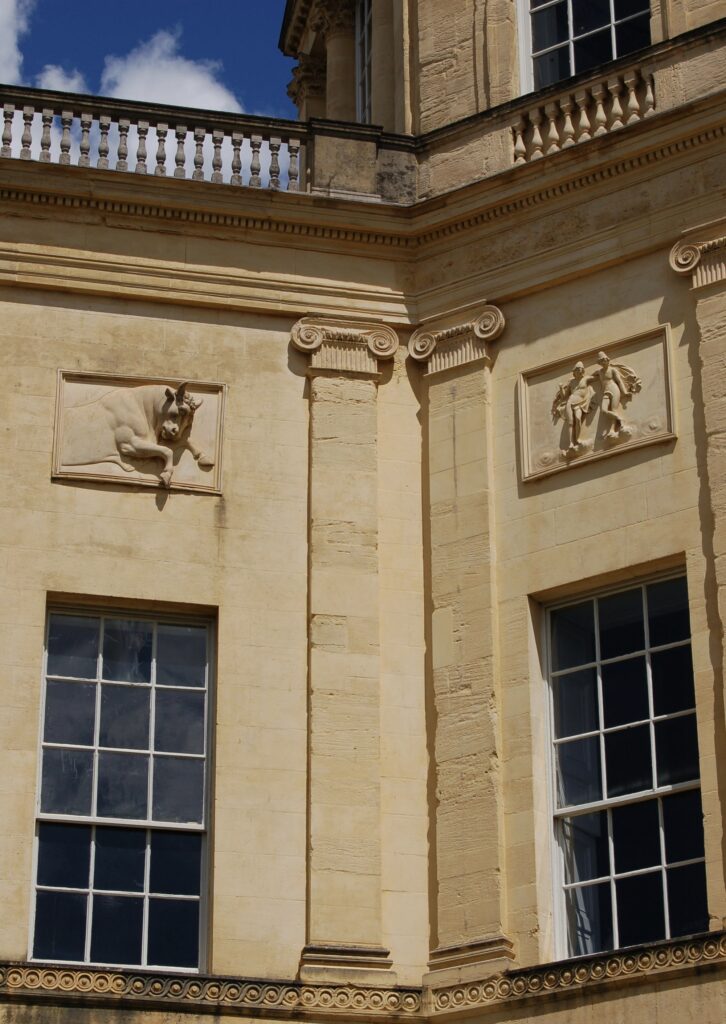
The signs of the zodiac, Taurus and Gemini (above) made from Coade, a composite stone that had just been invented and remains beautifully preserved.
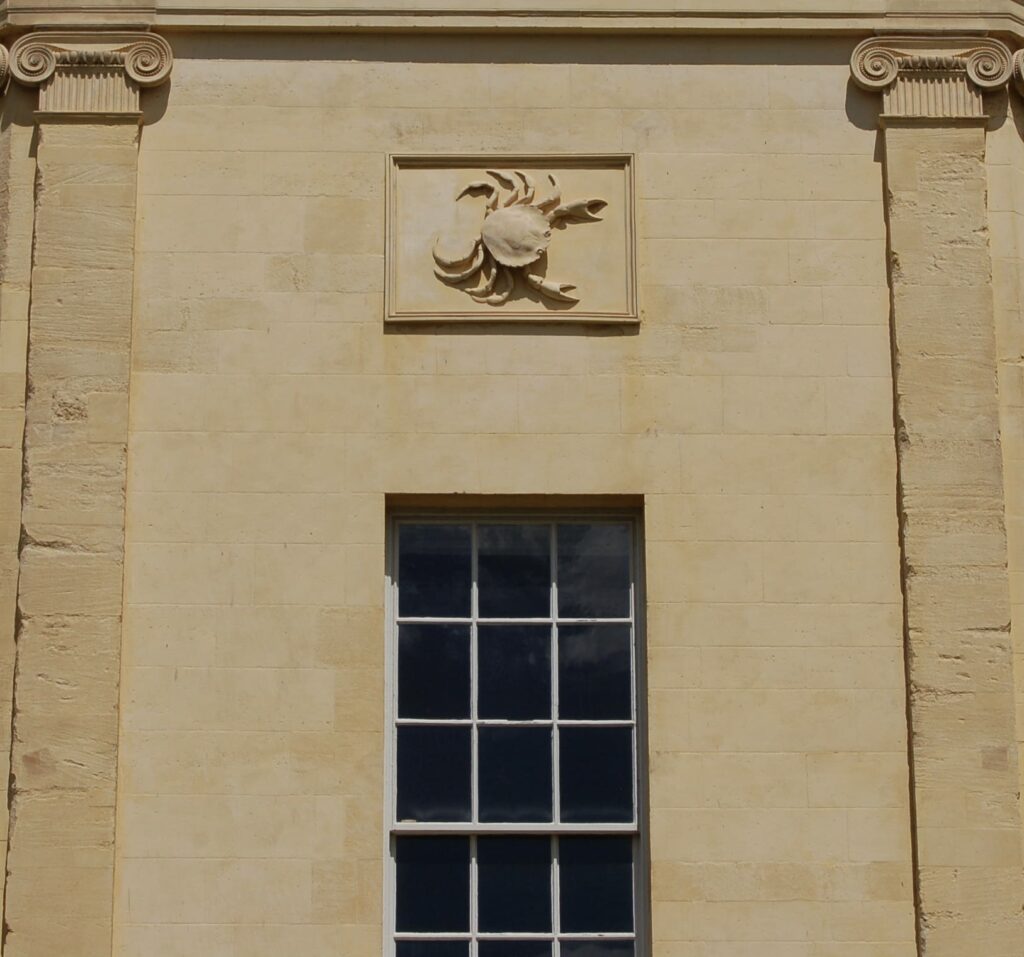
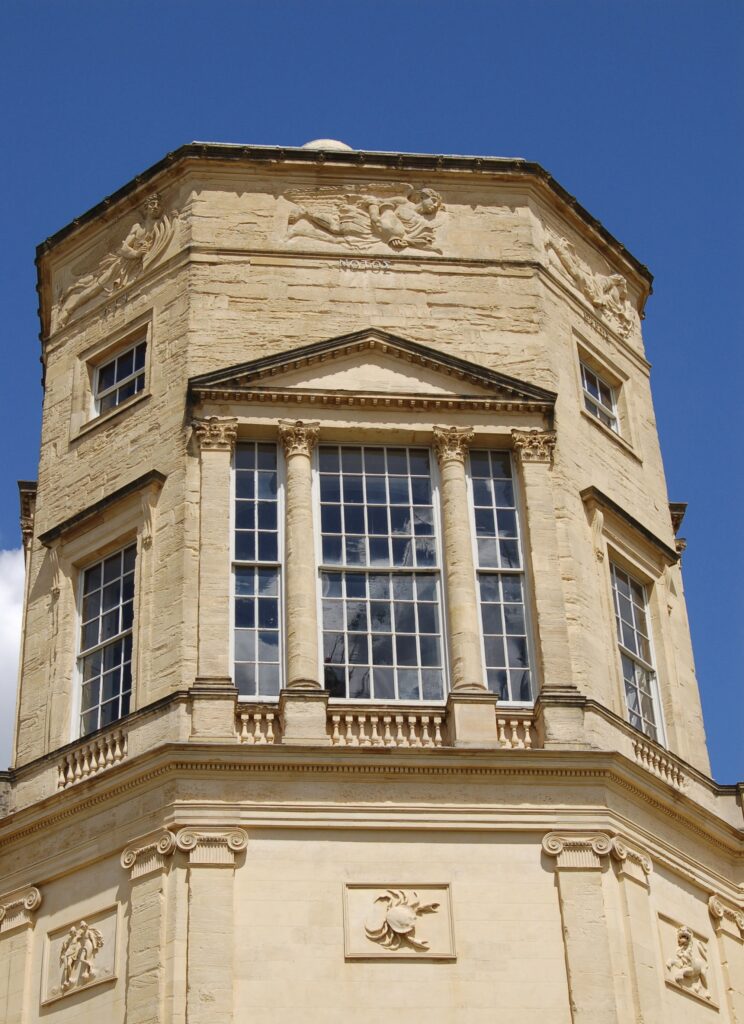
Notus, the south wind, sultry and wet, with his upturned amphora of rain water.

Illustrations made by James Stuart and Nicholas Revett in 1762 after visiting the Tower of the Winds in Athens, almost certainly copied by James Wyatt.

The Tower of the Winds in Athens.
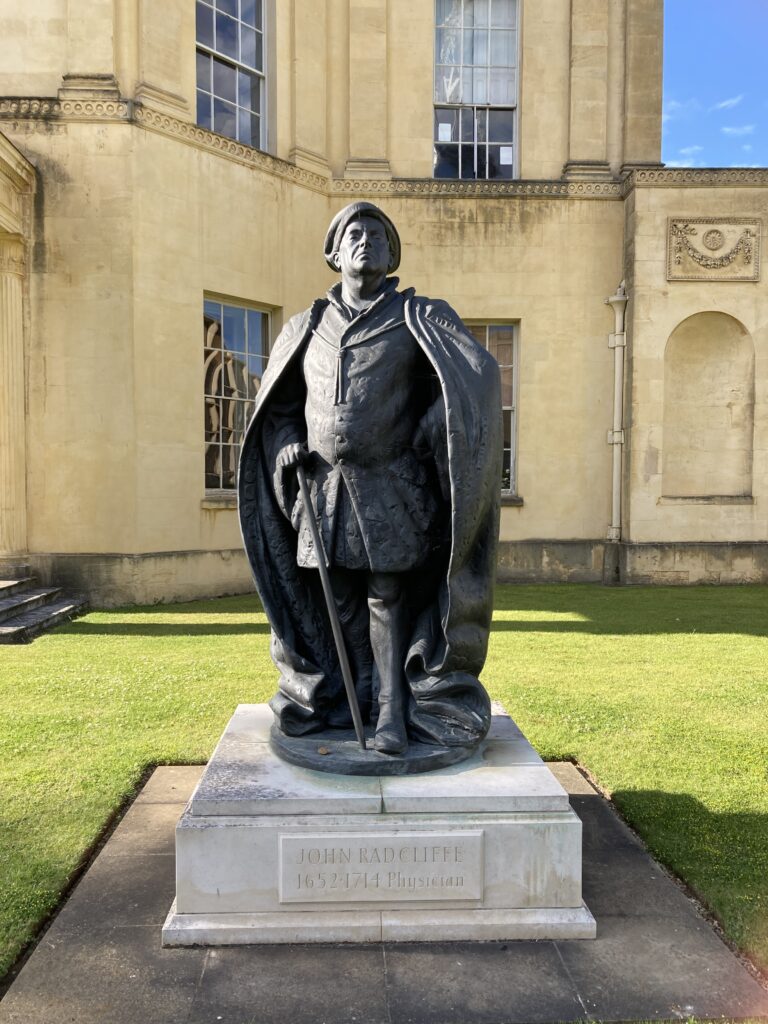
Statue of John Radcliffe by Martin Jennings (2014)
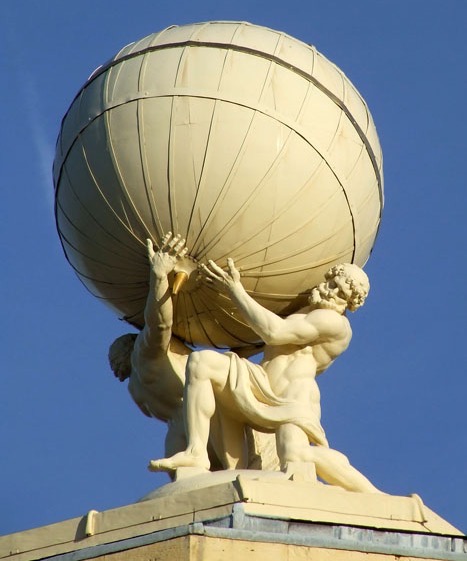
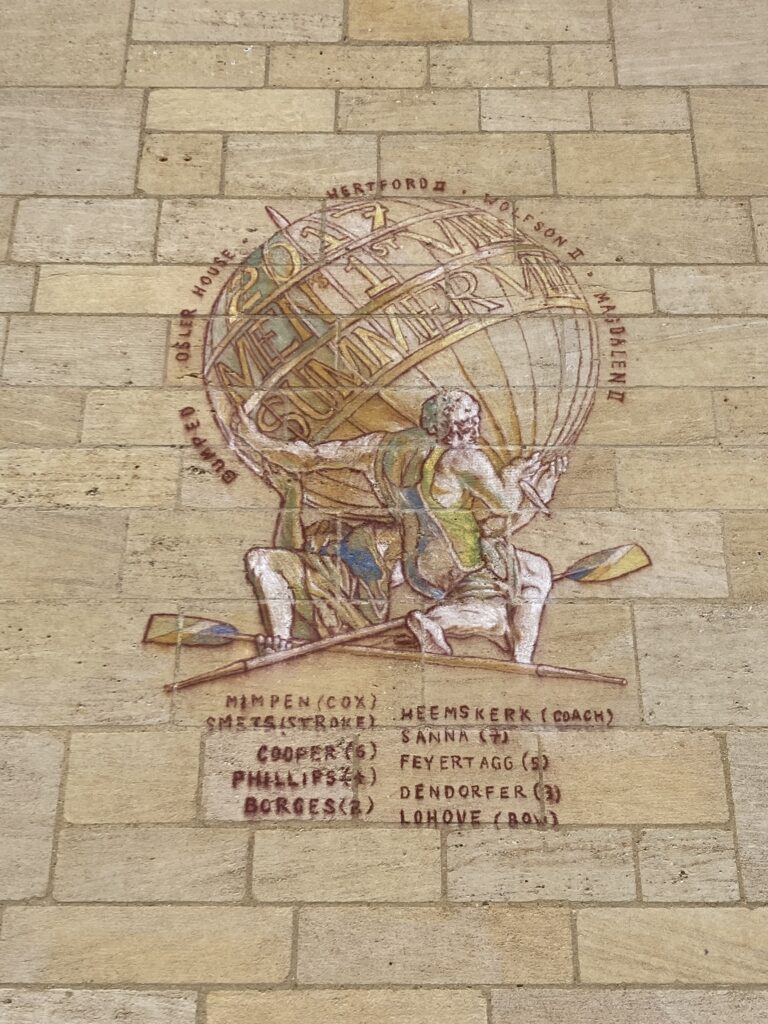
Atlas and Herakles holding up the globe – the story goes that Atlas taught Herakles all about the stars and so they are apt figures to be placed atop the Observatory. Rowing graffiti (right) on the college walls.
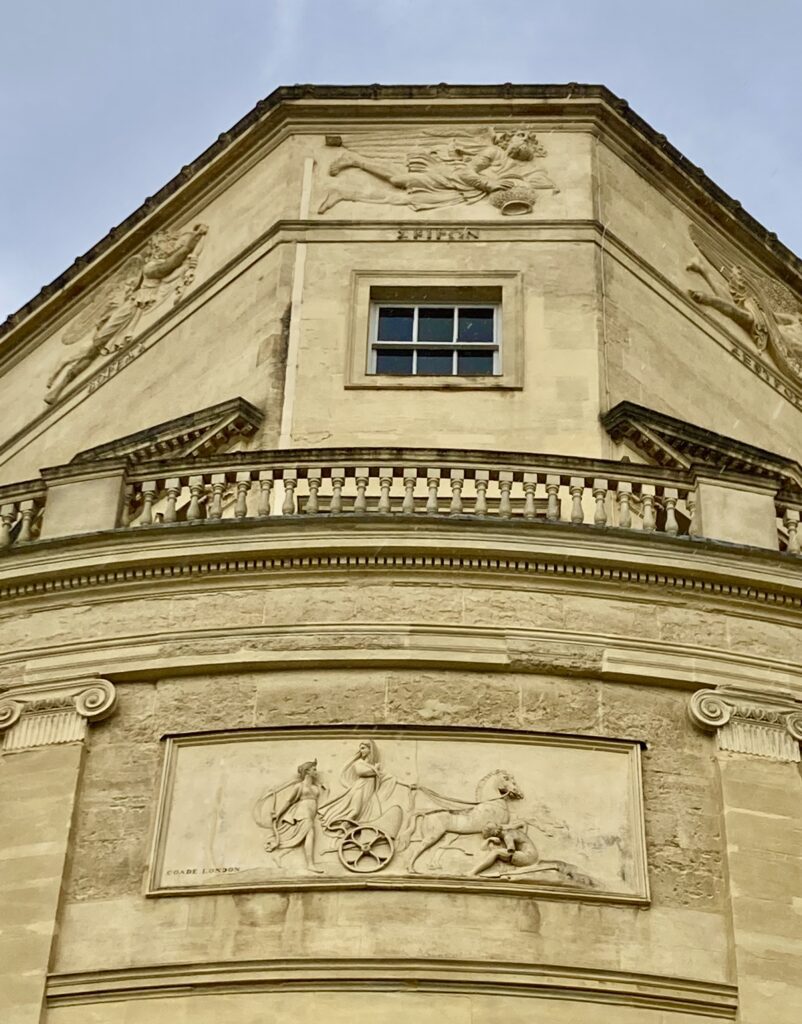
In between the signs of the zodiac on the college side of the Observatory are three panels representing morning, noon and evening, also made from Coade stone. This is Nyx (night) with Artemis (the moon) setting off in her chariot for the night.
Above them in Skiron, the north-west wind, the driest of the winds, carrying a cauldron thought to hold hot embers, representing the possibility of forest fires.
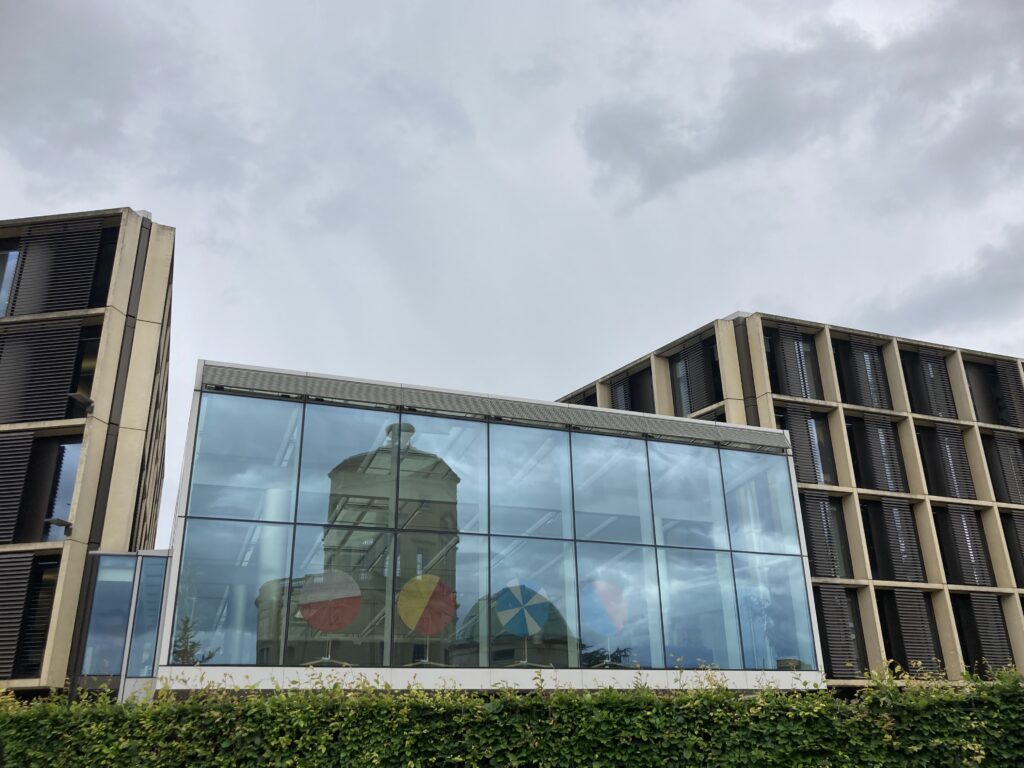
Reflections in the new buildings opposite.
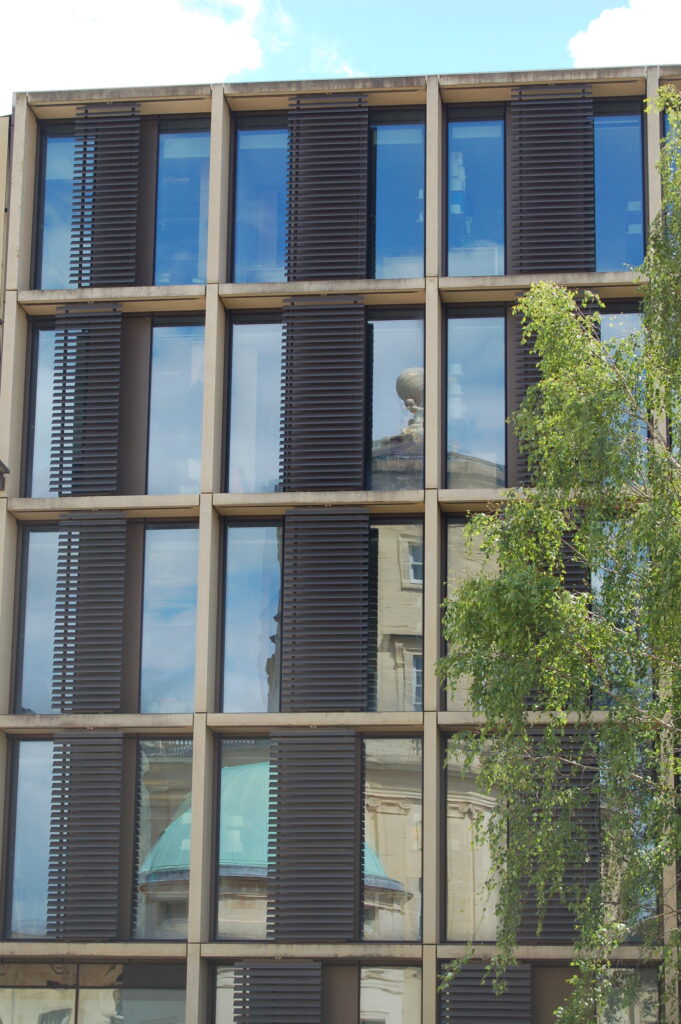
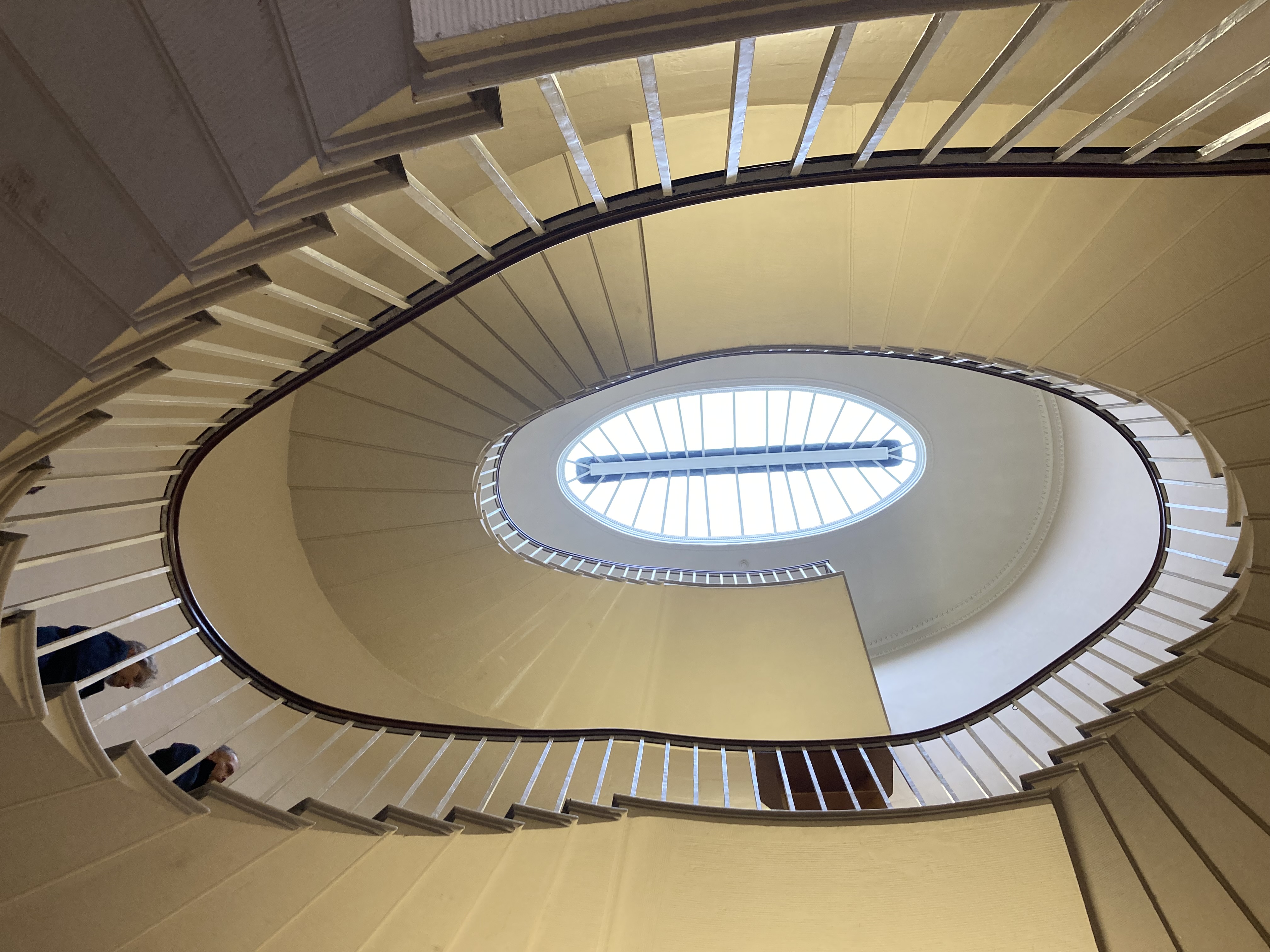
The oval staircase.
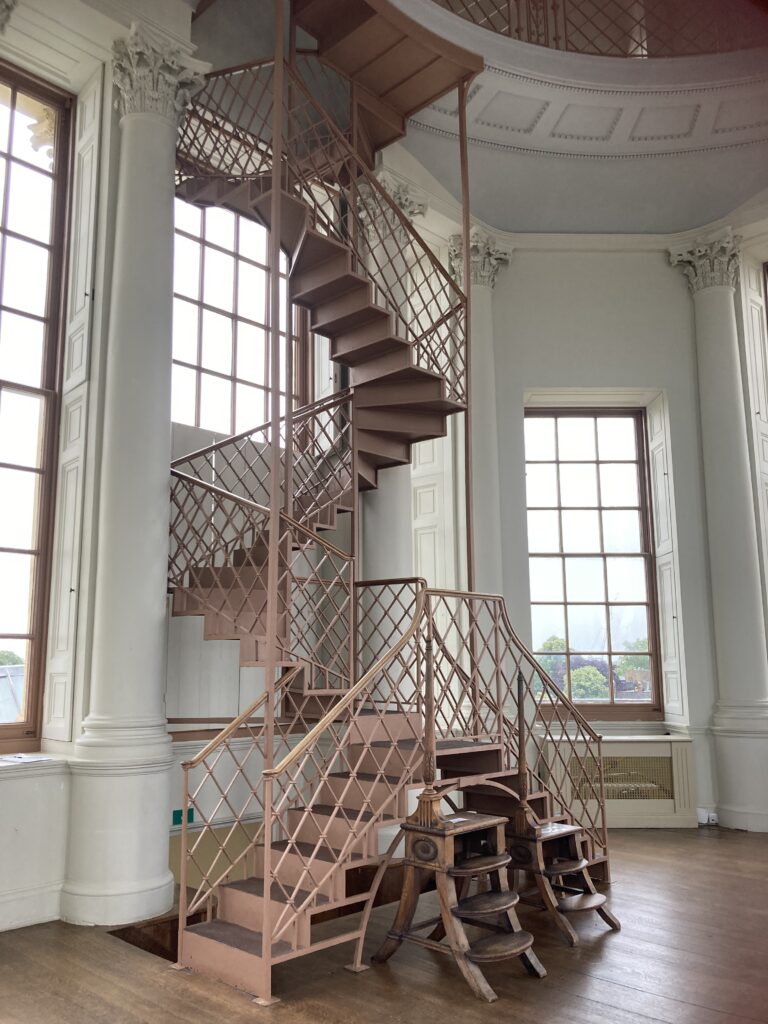
The top room, with the metal staircase taking you to the upper balcony. The wooden library steps are in fact telescope stands.
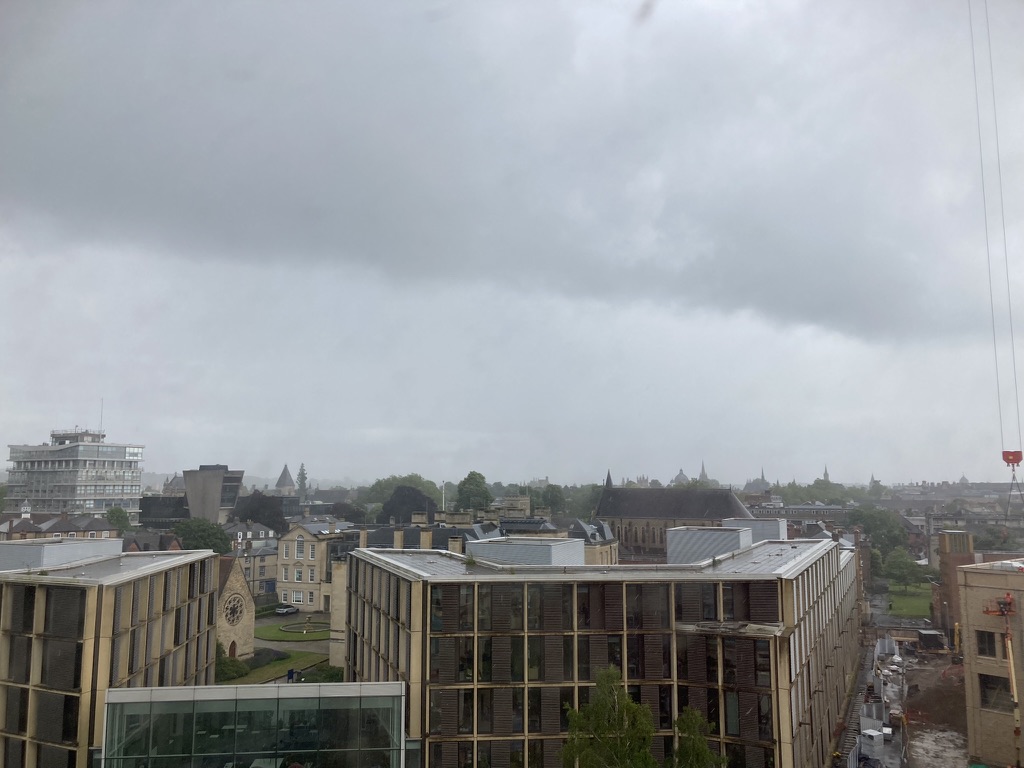
View south from the tower in the rain over the new Mathematical Institute and the old Radcliffe Infirmary towards Oxford’s ‘dreaming spires’.
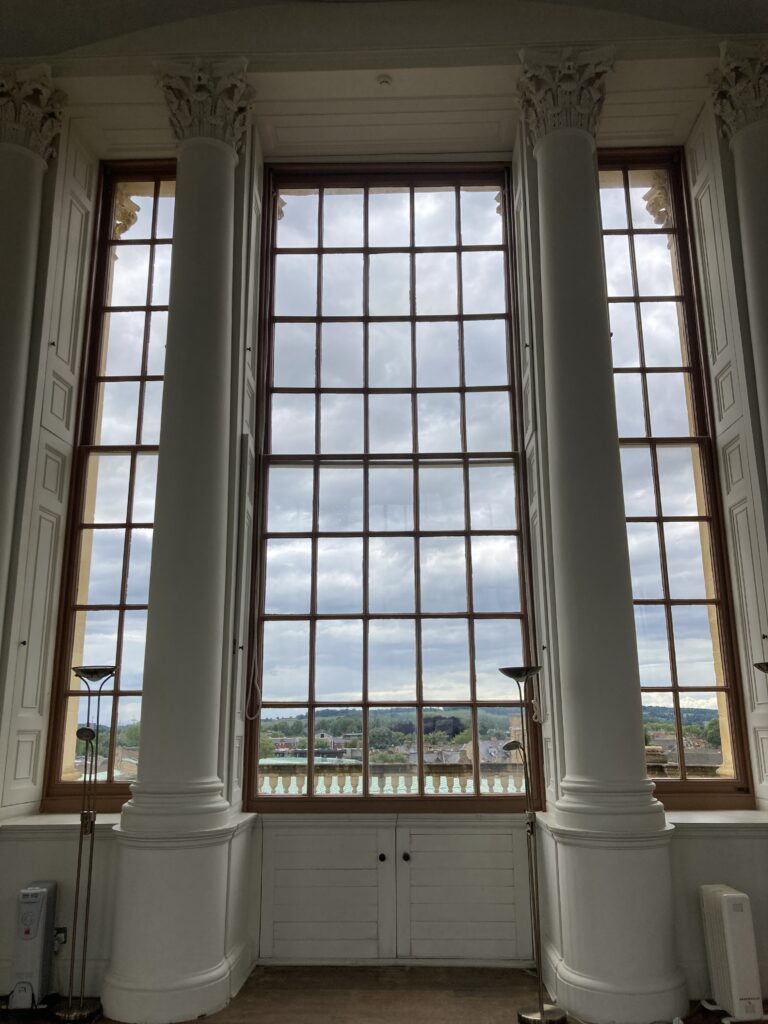
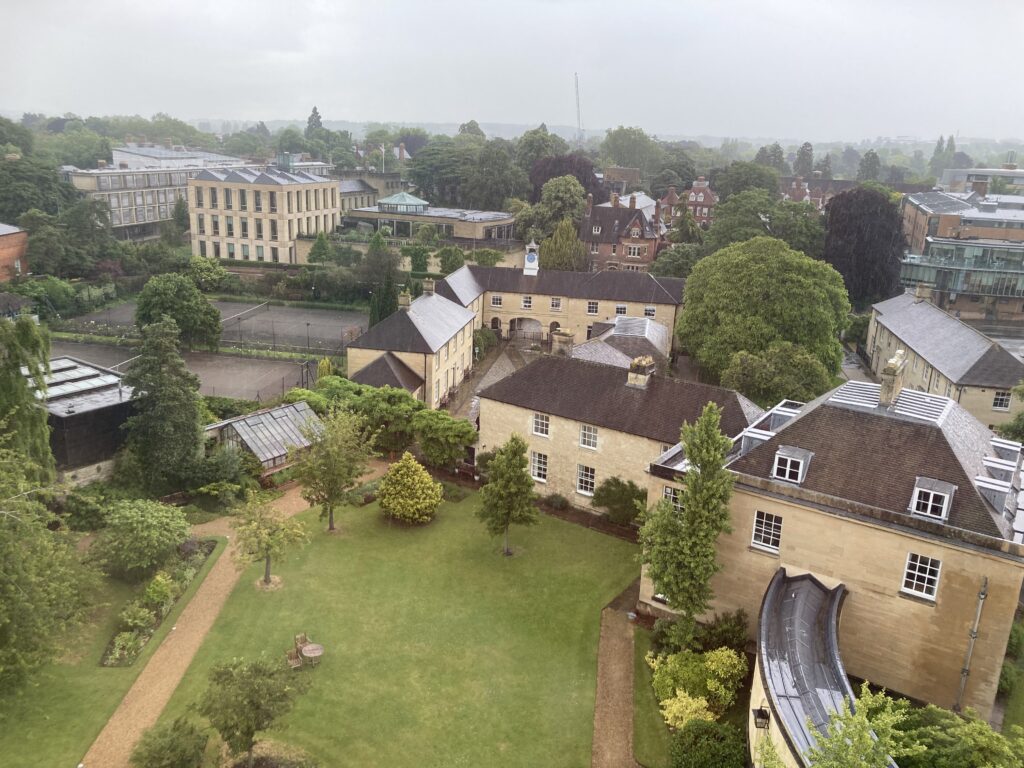
The Observer’s Garden was very nearly dug up to provide accommodation for nurses. The tennis courts were once the kitchen garden for The Observatory.
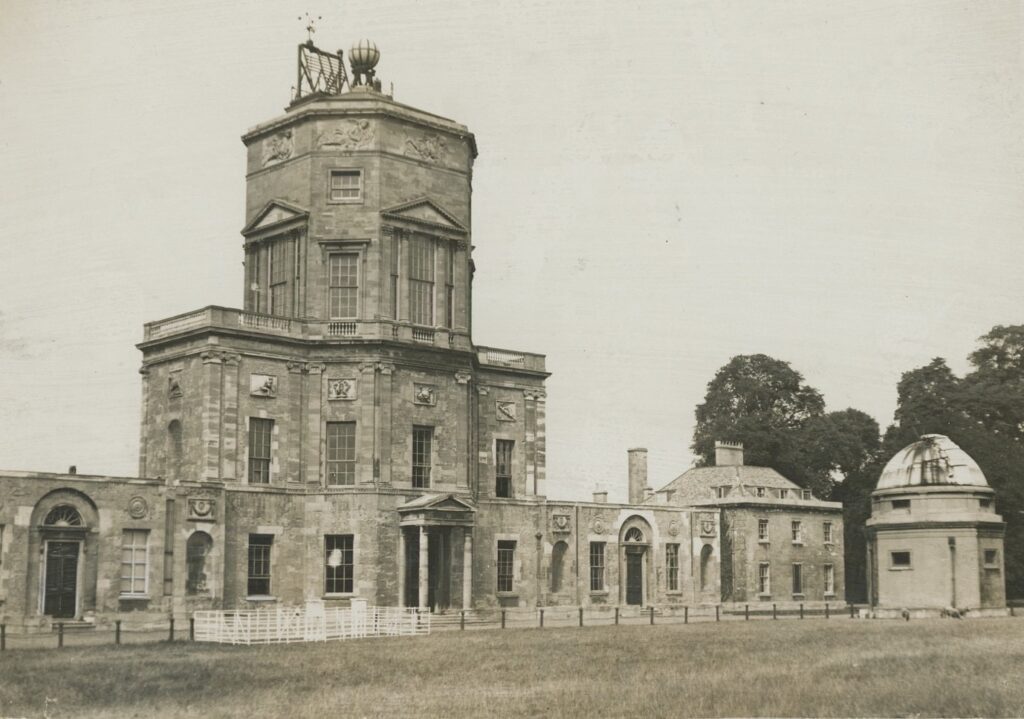
Radcliffe Meteorological Station – when it was situated to the south of the building in 1929 © Topical Press Agency
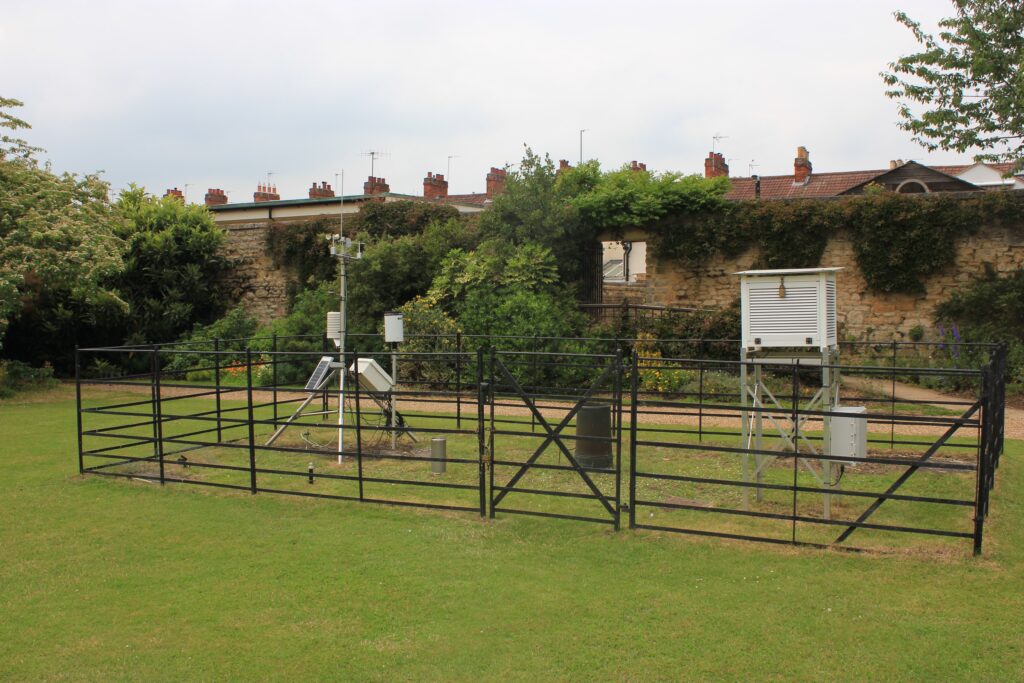
And in 2024.
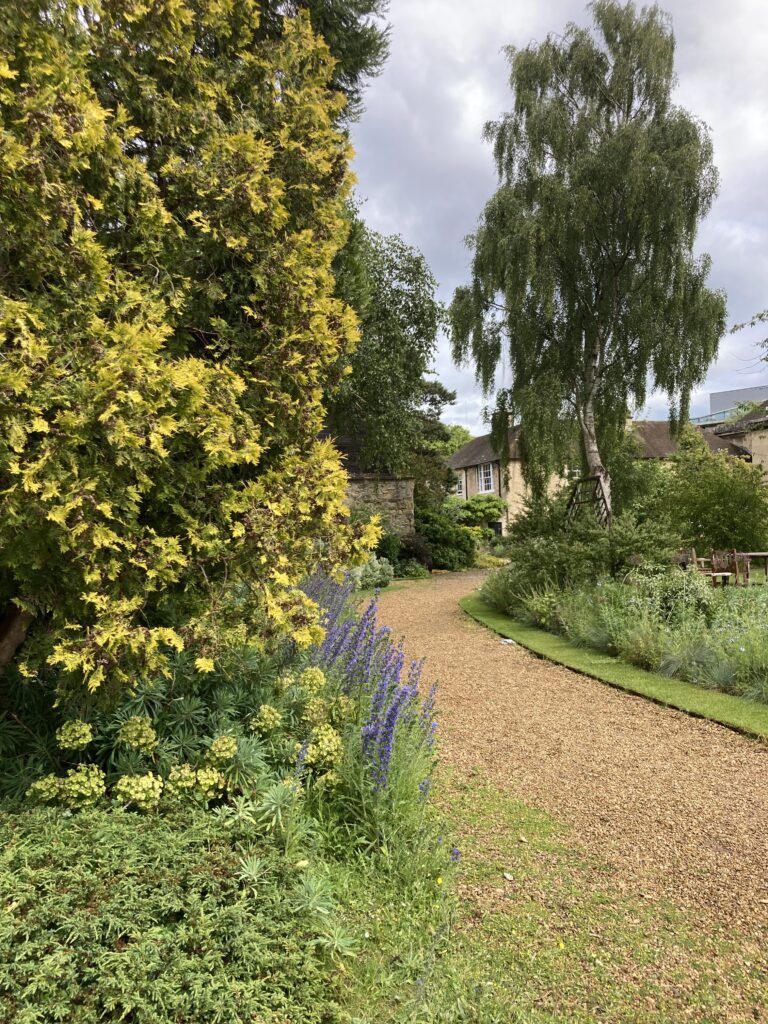
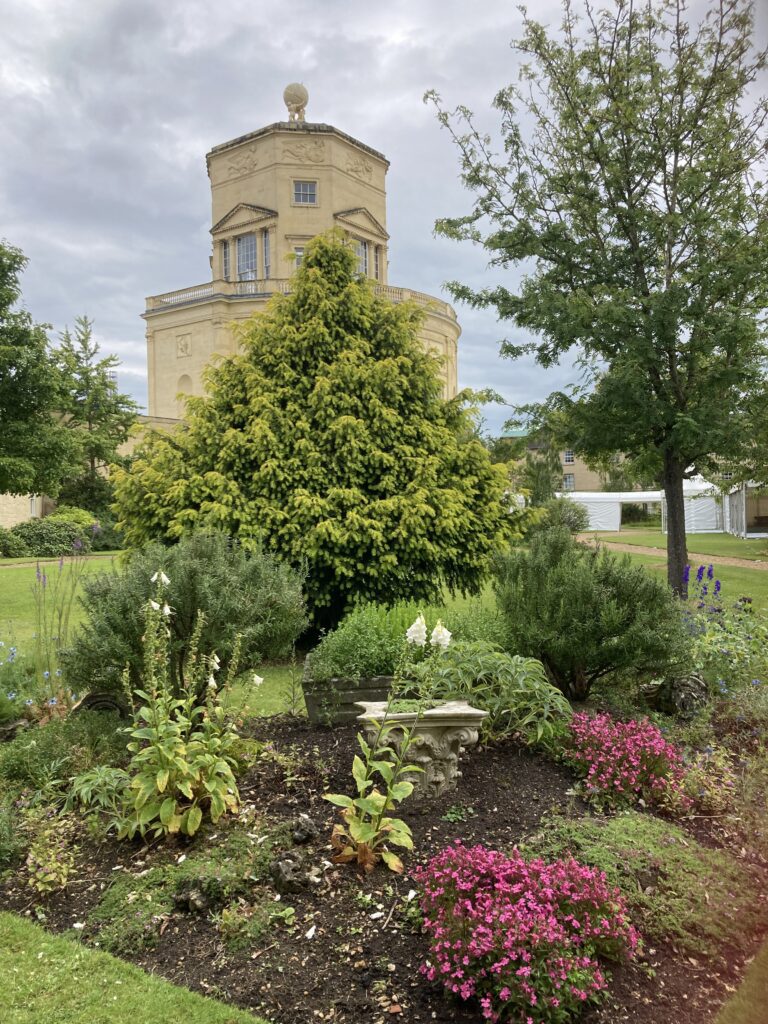
Michael Pirie’s Classical Garden, with fragments of Coade stone that have fallen from the Observatory, a Corinthian column and plants from the eastern Mediterranean.
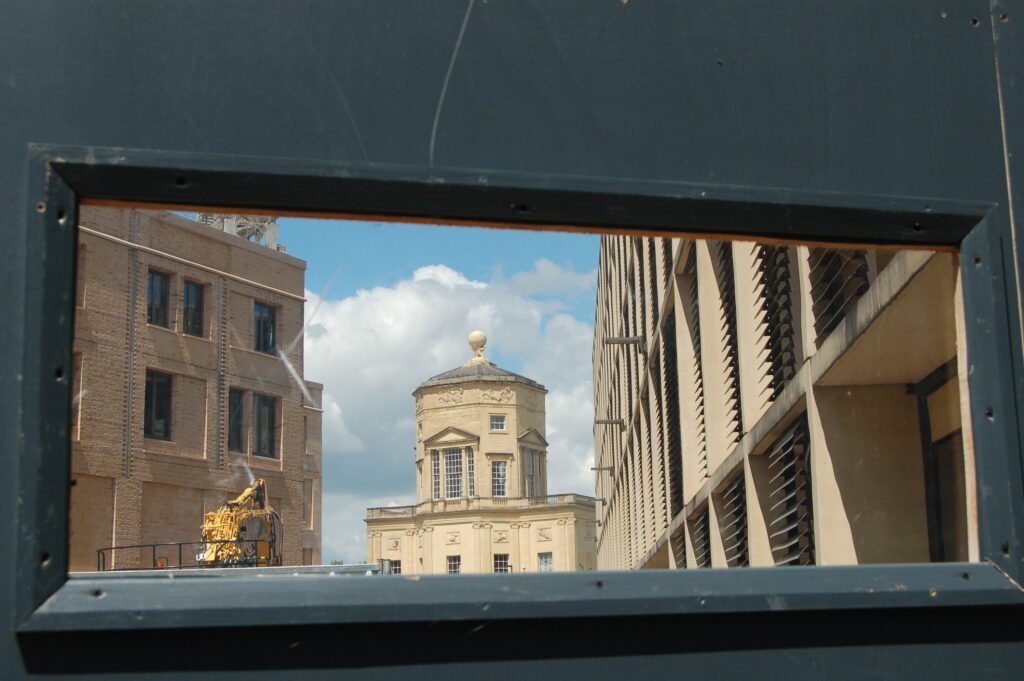
Snatched views of the Observatory.
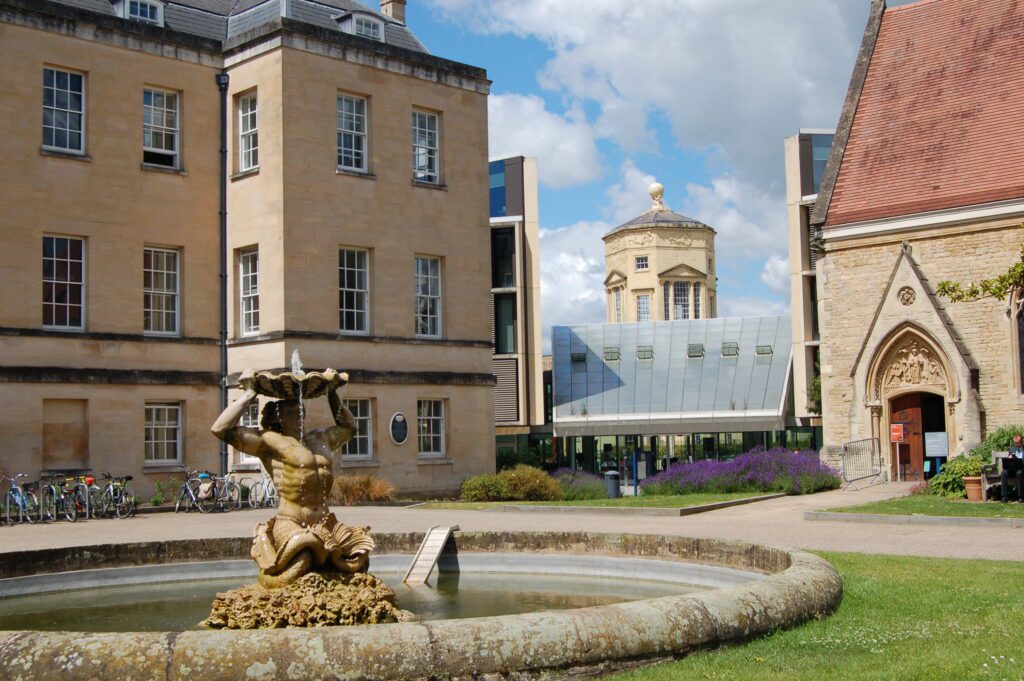
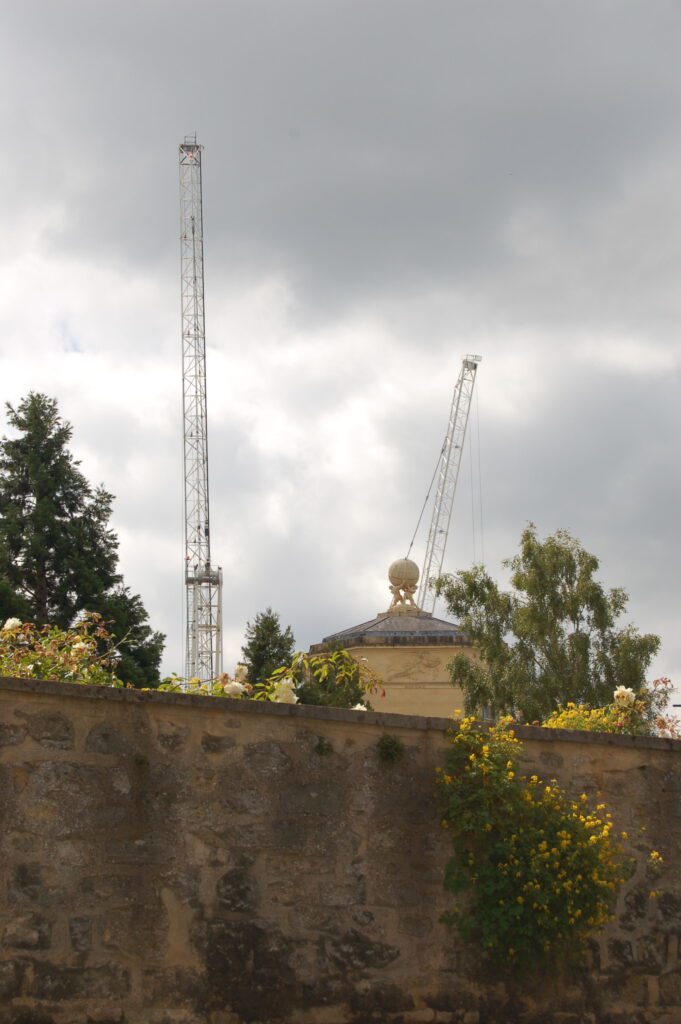
From Observatory Street, which backs on to it.
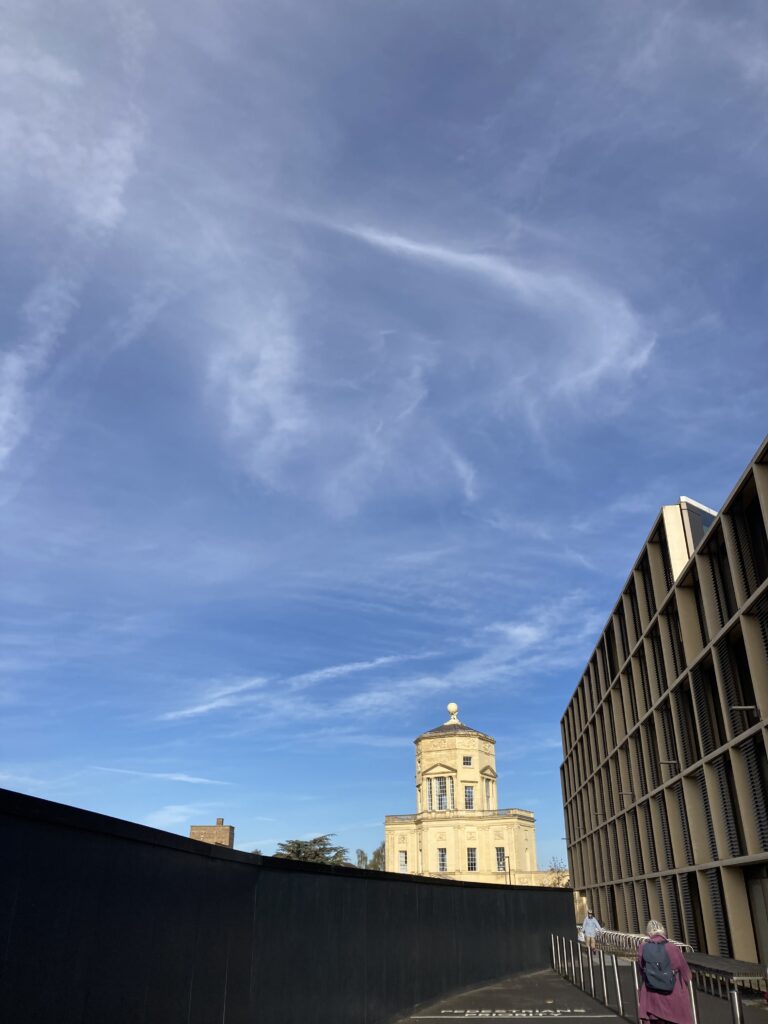
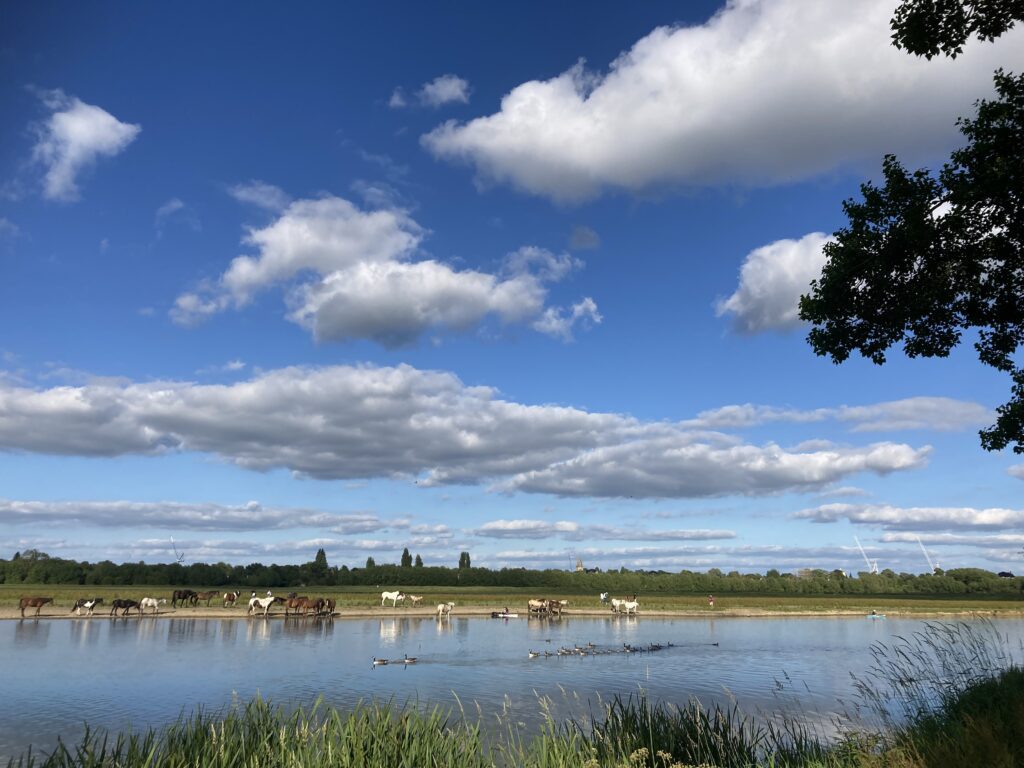
Just visible across Port Meadow to the left of the cranes.
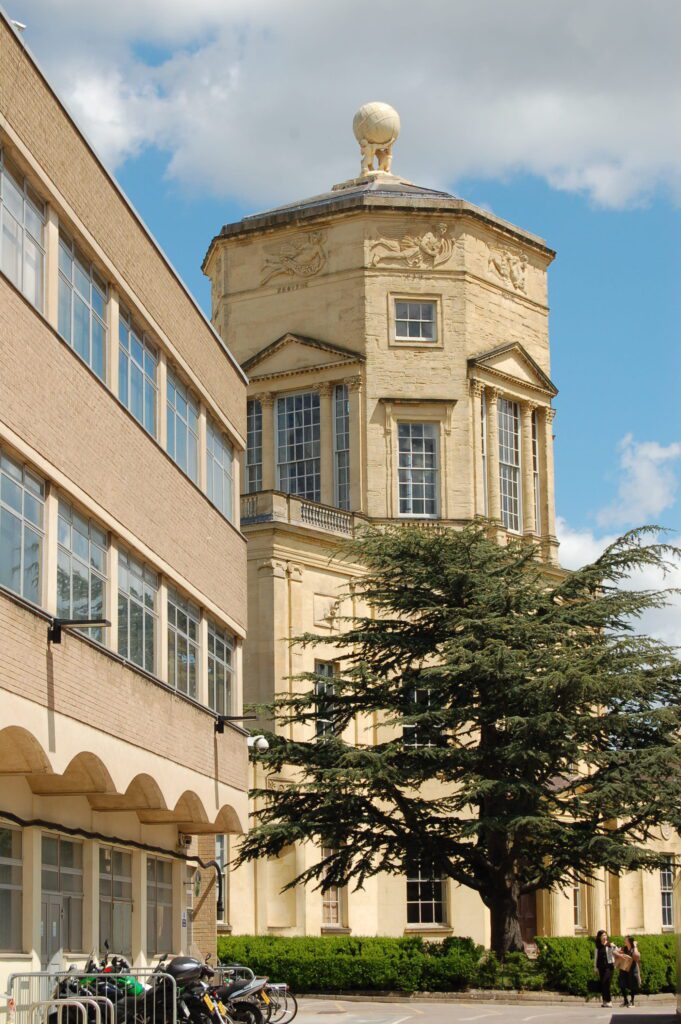
Michael Pirie’s Cedar of Lebanon which he planted when he first arrived to work in the gardens.
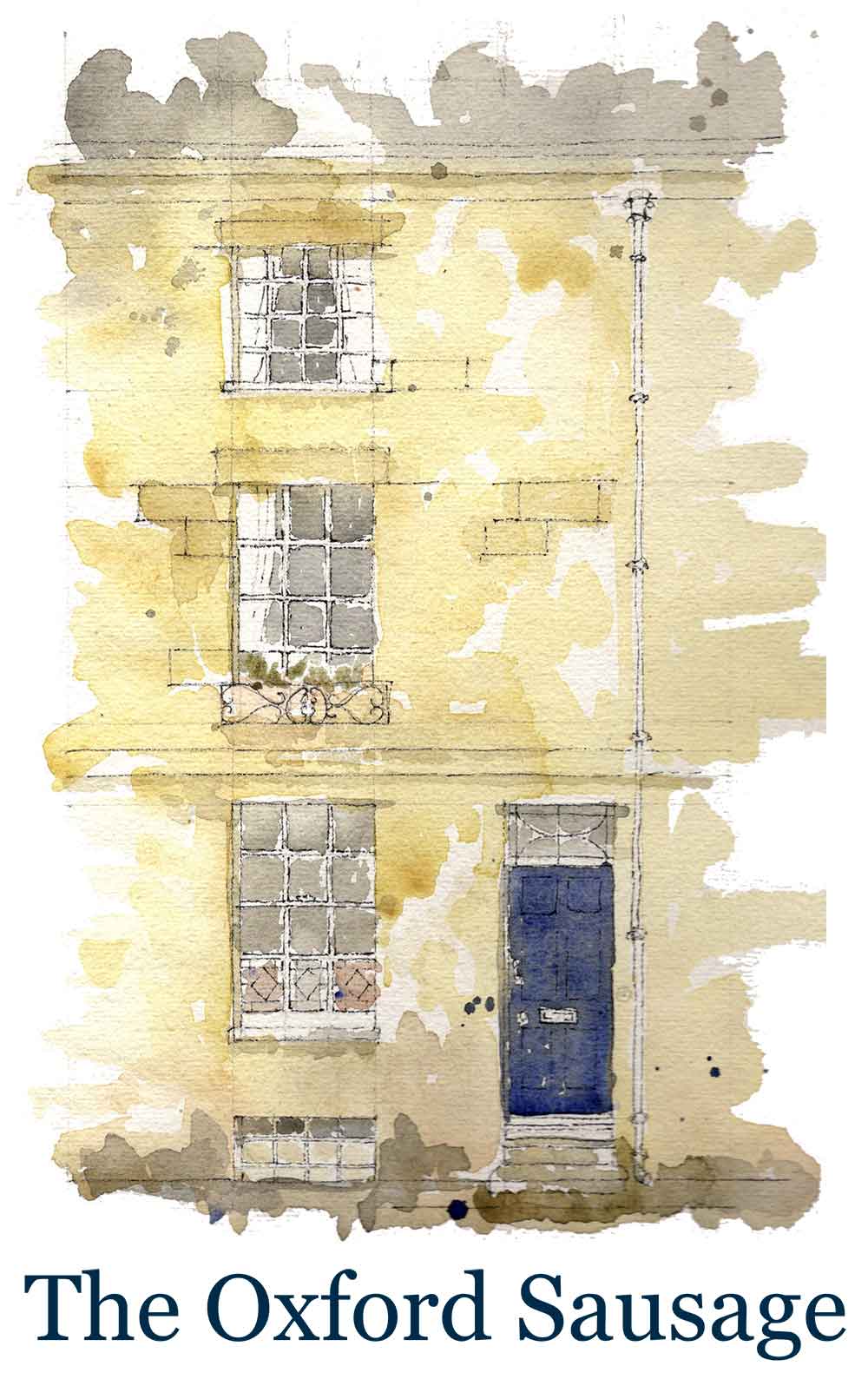
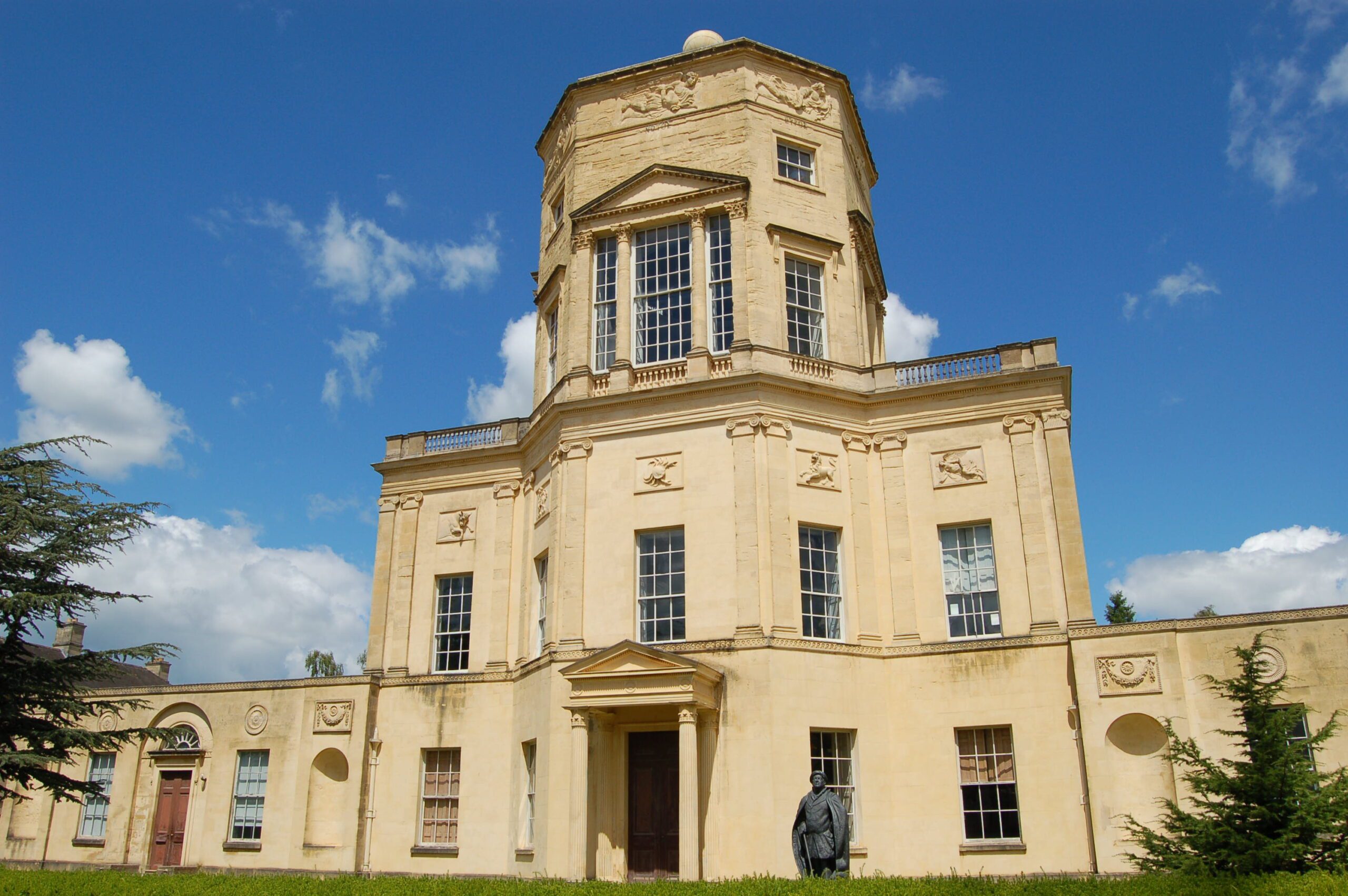
4 Comments
Join the discussion and tell us your opinion.
Beautifully written and pic’s are rather special, too!
Thanks you Nicolla
I remember a VW Beetle sitting on the top of this structure.
A collection of students completely disassembled then reassembled it.
Quite a feat I’m sure you will agree.
I really look forward to your articles each week. The history of Oxford vibrant and the stories that you find are fascinating.
I love how descriptive the writing is. The photography is truly excellent. Thank you so much for taking the time and effort to research and present this treat for us.